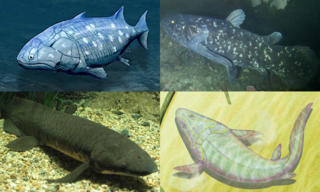
Sarcopterygii — sometimes considered synonymous with Crossopterygii — is a clade of vertebrate animals which includes a group of bony fish commonly referred to as lobe-finned fish. These vertebrates are characterised by prominent muscular limb buds (lobes) within their fins, which are supported by articulated appendicular skeletons. This is in contrast to the other clade of bony fish, the Actinopterygii, which have only skin-covered bony spines supporting the fins.

Eusthenopteron is a genus of prehistoric sarcopterygian fish known from several species that lived during the Late Devonian period, about 385 million years ago. It has attained an iconic status from its close relationship to tetrapods. Early depictions of animals of this genus show them emerging onto land, but paleontologists now think that eusthenopteron species were strictly aquatic animals, though this is not completely known.

Tetrapodomorpha is a clade of vertebrates consisting of tetrapods and their closest sarcopterygian relatives that are more closely related to living tetrapods than to living lungfish. Advanced forms transitional between fish and the early labyrinthodonts, such as Tiktaalik, have been referred to as "fishapods" by their discoverers, being half-fish, half-tetrapods, in appearance and limb morphology. The Tetrapodomorpha contains the crown group tetrapods and several groups of early stem tetrapods, which includes several groups of related lobe-finned fishes, collectively known as the osteolepiforms. The Tetrapodomorpha minus the crown group Tetrapoda are the stem Tetrapoda, a paraphyletic unit encompassing the fish to tetrapod transition.
Eoctenodus is an extinct genus of prehistoric sarcopterygian or lobe-finned fish.
Euporosteus is an extinct genus of prehistoric sarcopterygian or lobe-finned fish.
Cryptolepis is an extinct genus of prehistoric marine lobe-finned fish known from the Late Devonian of what is now eastern Europe. It contains a single species, C. grossi from the middle to late Famennian of Oryol, Russia and Latvia. Scales of this species are particularly common in Devonian localities of Latvia. It was named after paleontologist Walter R. Gross.
Indocoelacanthus robustus is a fossil sarcopterygian. The holotype specimen was found in Lower Jurassic-aged riverine sediment of the Kota formation, in the Pranhita-Godavari valley at Boraigudem limestone ridge, about 30 kilometers southeast of Sironcha, India. The holotype is preserved in the museum of the Indian Statistical Institute.
Hainbergia is an extinct genus of prehistoric sarcopterygian or lobe-finned fish.
Hamodus is an extinct genus of prehistoric sarcopterygian or lobe-finned fish.

Megapleuron is an extinct genus of prehistoric sarcopterygian or lobe-finned fish that lived during the Asselian age of the Cisuralian epoch in what is now Burgundy, France.
Rhipis is an extinct genus of prehistoric sarcopterygians or lobe-finned fish.
Pseudosauripterus is an extinct genus of prehistoric sarcopterygians or lobe-finned fish.

Porolepis is an extinct genus of porolepiform sarcopterygian fish, from the Early Devonian Dniester Series of Ukraine, which is rich in Porolepis remains, and also the Nellen Koepfchen Beds of Germany. It lived alongside the dubious lophotrochozoan Macrodontophion. It was first described in 1858 but Porolepis was not named as a sufficient species until 1891.
Phaneropleuron is an extinct genus of prehistoric sarcopterygians or lobe-finned fish.
Pentlandia is an extinct genus of prehistoric sarcopterygians or lobe-finned fish. Its first discovered species was initially named Dipterus macroptera by Ramsay Traquair in 1888, then renamed Pentlandia macroptera by D.M.S. Watson and H. Day in 1916.
Youngichthys is an extinct genus of prehistoric sarcopterygians or lobe-finned fish from the upper Permian (Changhsingian) comprising a single species, Youngichthys xinghuansis. The single specimen of the fish was discovered in Zhejiang Province, China in 1981.
Ventalepis is an extinct genus of prehistoric sarcopterygians or lobe-finned fish.
Tranodis is an extinct genus of prehistoric sarcopterygians or lobe-finned fish. It was a lungfish from the Upper Mississippian of North America.
Straitonia is an extinct genus of prehistoric sarcopterygian, or lobe-finned fish.










